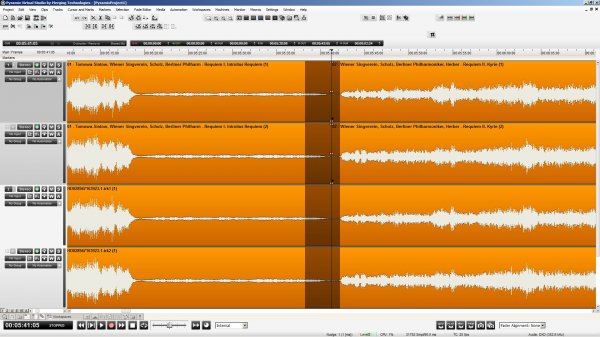Ripping SACDs the right way
- Thread starter gsquared
- Start date
-
- Tags
- ripping sacds
You are using an out of date browser. It may not display this or other websites correctly.
You should upgrade or use an alternative browser.
You should upgrade or use an alternative browser.
Now let's look at Pink Floyd - DSOTM. The track divisions happen where the mastering engineer put the codes for the laser to start/stop. Now if these track divisions don't happen at a zero crossing, you get ticks/pops. It's especially pronounced on Classical albums where some tracks happen between soft movements.
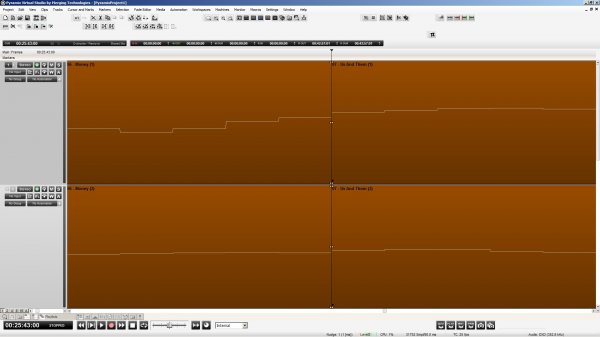

You've mentioned that with some discs the PS3 rip was missing entire (hidden) tracks. Can you name one such disc?
You also mention smaller amounts of audio missing from some rips. If you remember, I'd be interested in a specific example of this as well.
In another thread you say there are issues when there is continuous music across a track boundary, giving DSOTM as an example. Could you be more specific about what goes wrong with these discs?
Please don't get me wrong. I do not doubt that the rips are indeed different. My reason for asking is that I'd like to figure out why they are different rather than simply dismissing the PS3 out of hand.
You might want to read this thread as well.
Ripping SACDs the right way
Here is the DG release of Mozart: Requiem - Karajan UPC028947163923
The PS3 rip is on the top and the Sonoma rip is on the bottom. Right from the beginning, these 2 are different.
Now we're getting somewhere. I can see some differences in your screenshots. Does this disc also have audio missing from the PS3 rip?
Here's just another example. Fantasy Records - Chet Baker - In New York UPC025218733168
Here it is aligned bit perfect at the beginning.
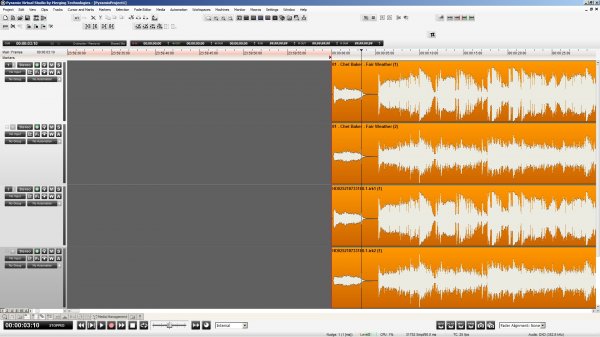
The whole screen shot.
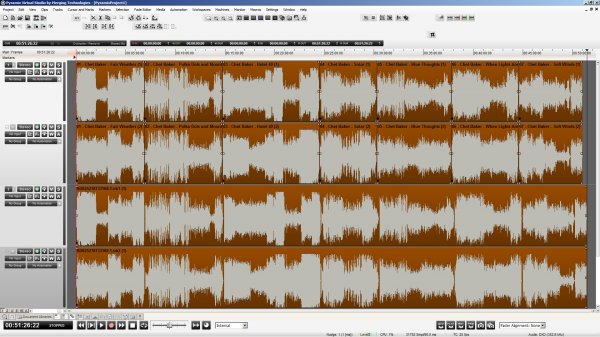
Now the end....
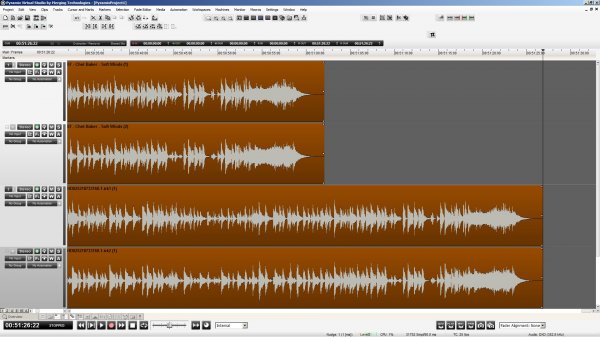
See... this time the mastering engineer cut out 26 seconds of silence between tracks. Sometimes they cut things out like applause or chatter. It all depends on where the TOC codes are.
Here it is aligned bit perfect at the beginning.

The whole screen shot.

Now the end....

See... this time the mastering engineer cut out 26 seconds of silence between tracks. Sometimes they cut things out like applause or chatter. It all depends on where the TOC codes are.
Now let's look at Pink Floyd - DSOTM. The track divisions happen where the mastering engineer put the codes for the laser to start/stop. Now if these track divisions don't happen at a zero crossing, you get ticks/pops. It's especially pronounced on Classical albums where some tracks happen between soft movements.
What exactly are we looking at here? Did you convert the tracks to PCM individually and then join them?
Cuts in a DSD stream must, as you say, be placed at a zero. If some discs are mastered with track markers at arbitrary positions, this means we need to be careful when splitting the continuous stream into individual tracks after ripping. It does not necessarily mean the PS3 rip is incorrect.
Here's just another example. Fantasy Records - Chet Baker - In New York UPC025218733168
See... this time the mastering engineer cut out 26 seconds of silence between tracks. Sometimes they cut things out like applause or chatter. It all depends on where the TOC codes are.
So there are snippets of audio between tracks not marked as belonging to either? That sounds plausible, and the data should be in the ISO image extracted with the PS3 even if subsequent splitting into tracks lost it. If this is the case, fixing it shouldn't be hard.
Here's just another example. Fantasy Records - Chet Baker - In New York UPC025218733168
Unfortunately I can't find that one for a reasonable price. I'm not going to spend £50 or more on an experiment.
Now we're getting somewhere. I can see some differences in your screenshots. Does this disc also have audio missing from the PS3 rip?
Yes, there is missing data
What exactly are we looking at here? Did you convert the tracks to PCM individually and then join them?
Cuts in a DSD stream must, as you say, be placed at a zero. If some discs are mastered with track markers at arbitrary positions, this means we need to be careful when splitting the continuous stream into individual tracks after ripping. It does not necessarily mean the PS3 rip is incorrect.
No, these are the .dff files that the PS3 created. I have done nothing to them.
Unfortunately I can't find that one for a reasonable price. I'm not going to spend £50 or more on an experiment.
Do you have a Sonoma system to compare to?
Yes, there is missing data
Between tracks as with the Chet Baker disc?
No, these are the .dff files that the PS3 created. I have done nothing to them.
Well, to display the waveform, something has to convert it from 1-bit form.
Do you have a Sonoma system to compare to?
No, but if I were to succeed in locating the right amount of audio data, that should be good enough. I was hoping you or someone else would be able to tell me the correct total duration.
Just to be absolutely clear, is this the Mozart disc you referred to: http://www.amazon.co.uk/Mozart-Requiem-W/dp/B000079BGJ
Between tracks as with the Chet Baker disc?
Yes
Well, to display the waveform, something has to convert it from 1-bit form.
I use a Pyramix and Sonoma workstation. You will have to contact the manufacturers to see how they create a waveform for a DSD file.
Mods.... can you take the last few pages of this thread (from post #329 -> )and move it into the appropriate thread, such as this.
http://www.whatsbestforum.com/showthread.php?3341-Ripping-SACDs-the-right-way
Answering Bruce's comment, which I interpreted as referring to the final DAC process.This is beside the point. The question was whether a digital rip of an SACD done on a PS3 contains different DSD data from a rip done using a digital SACD transport into a Sonoma workstation. Filters do not enter the picture in either of those cases.
+1If PS3 rips are inferior to Sonoma rips, there has to be a reason for this. I'd like to find out what it is and hopefully correct it. The first step would be to acquire an SACD known to reveal these differences, so could someone please name some specific titles?
Of all that has been said, this is truly the most bizarre thing of all. If you aligned the beginning and the end is off by a couple of seconds, then the only possible explanations I can imagine are:Here's just another example. Fantasy Records - Chet Baker - In New York UPC025218733168
Here it is aligned bit perfect at the beginning.
View attachment 22327
The whole screen shot.
View attachment 22328
Now the end....
View attachment 22329
See... this time the mastering engineer cut out 26 seconds of silence between tracks. Sometimes they cut things out like applause or chatter. It all depends on where the TOC codes are.
1- There are notes missing in the shorter rip or blanks added in the longer one
2- Somehow the clocks are different by a large amount
How can this possibly be???
Edit: Let me clarify: something cut in the middle like a silence or pause would be reasonable. But looking at the waveform, and assuming you aligned the beginning of a track with the end of the same track, it just doesn't make any sense that this one track would be that different.
If you're saying that after 51 mins and many tracks the Sonoma rip is longer simply because it had a longer leader or tail in each track, well, that's not surprising I don't think, and not meaningful really.
Track start and stop timings for SACD rips performed by PS3 and SACD_extract (or similar software), are determined by the PQ markers embedded in the cutting master for SACD production. Those markers are intended to run the SACD player display metadata, and have no actual conection to the music content, other than where the mastering engineer placed them. Normally that's about one second prior to music start. It's simply a situation of where the extract software used to facilitate automatic track slicing of the continuous album file uses data (PQ markers) not intended for that purpose.
Sonoma track starts and stops are determined manually by when the Record button is hit. The SACD transport is free running, and has no control of Sonoma's operation. So therefore some time buffer amount is usually built-in. Like I start the Sonoma's Record, then hit Play on the transport.
So in Bruce's examples, some PQ Marker(s) are within the music content, and therefore the track data prior was not included in the track by the SACD_extract software. Also, PQ markers are both Start and Stop types. Most DSD edited masters I work with have an album beginning Start marker, then more Start markers at the beginning of each new track, and a Stop marker at the end of the last track. But sometimes the mastering guy put a Stop marker at a track end, followed by an inter track time, then a Start marker at the new track beginning. I have no idea how SACD_extract treats these occasional Stop markers, and whether it cuts out the time between the Stop and succeeding Start marker when slicing.
Sonoma track starts and stops are determined manually by when the Record button is hit. The SACD transport is free running, and has no control of Sonoma's operation. So therefore some time buffer amount is usually built-in. Like I start the Sonoma's Record, then hit Play on the transport.
So in Bruce's examples, some PQ Marker(s) are within the music content, and therefore the track data prior was not included in the track by the SACD_extract software. Also, PQ markers are both Start and Stop types. Most DSD edited masters I work with have an album beginning Start marker, then more Start markers at the beginning of each new track, and a Stop marker at the end of the last track. But sometimes the mastering guy put a Stop marker at a track end, followed by an inter track time, then a Start marker at the new track beginning. I have no idea how SACD_extract treats these occasional Stop markers, and whether it cuts out the time between the Stop and succeeding Start marker when slicing.
Last edited:
Of all that has been said, this is truly the most bizarre thing of all. If you aligned the beginning and the end is off by a couple of seconds, then the only possible explanations I can imagine are:
1- There are notes missing in the shorter rip or blanks added in the longer one
2- Somehow the clocks are different by a large amount
How can this possibly be???
It appears that some discs have inter-track audio data not tagged as belonging to any track. When extracting single tracks from the ISO image, this data is skipped. A clock error would result in duplicated samples, which would likely sound terrible, and even if it didn't, a time stretching of this magnitude is easily audible.
Looks like processing applied (fade in/out at begin/end).
May be need turn OFF processing in settings (software that process 2 bottom tracks)?
Here same example how remove clicks via fade in/out.
As alternative can be used seamless conversion.
Fade in/out processing allow pass by clicks due player gapless disability (if player don't support gapless playback).
Also begin/end clicks passed by if tracks played separatelly (not into its album).
Other hand, fade in/out can give some irregularity at track borders. For minimizing audible irregularity can be applied special tricks of fade in/out.
Last edited:
Exactly. This is a non-issue.Track start and stop timings for SACD rips performed by PS3 and SACD_extract (or similar software), are determined by the PQ markers embedded in the cutting master for SACD production. Those markers are intended to run the SACD player display metadata, and have no actual conection to the music content, other than where the mastering engineer placed them. Normally that's about one second prior to music start. It's simply a situation of where the extract software used to facilitate automatic track slicing of the continuous album file uses data (PQ markers) not intended for that purpose.
Sonoma track starts and stops are determined manually by when the Record button is hit. The SACD transport is free running, and has no control of Sonoma's operation. So therefore some time buffer amount is usually built-in. Like I start the Sonoma's Record, then hit Play on the transport.
What I really want to know is: take one track, and align the dsd streams (if they match at all this should be possible). Now compared those streams in the digital domain. Are they different? If they aren't, case closed. If they are, change them to a waveform and do the diff. What's the frequency distribution of this diff?So in Bruce's examples, some PQ Marker(s) are within the music content, and therefore the track data prior was not included in the track by the SACD_extract software. Also, PQ markers are both Start and Stop types. Most DSD edited masters I work with have an album beginning Start marker, then more Start markers at the beginning of each new track, and a Stop marker at the end of the last track. But sometimes the mastering guy put a Stop marker at a track end, followed by an inter track time, then a Start marker at the new track beginning. I have no idea how SACD_extract treats these occasional Stop markers, and whether it cuts out the time between the Stop and succeeding Start marker when slicing.
Different lengths, as long as it's from leader/tail is a non-issue really (yes there could be cases where some music was cut - mastering markers should be to blame). Hidden tracks - sure whatever.
Ok. So same tracks, aligned at the start, eventually gets out of sync? Example please.It appears that some discs have inter-track audio data not tagged as belonging to any track. When extracting single tracks from the ISO image, this data is skipped. A clock error would result in duplicated samples, which would likely sound terrible, and even if it didn't, a time stretching of this magnitude is easily audible.
Similar threads
- Replies
- 4
- Views
- 3K
- Replies
- 7
- Views
- 4K
- Replies
- 16
- Views
- 5K
- Replies
- 4
- Views
- 3K
Members online
- Big Dog RJ
- Kingsrule
- mtemur
- jbrrp1
- bonzo75
- Rocoa
- audiolab
- dan31
- Argonaut
- Pacha
- ticktock
- thedudeabides
- andromedaaudio
- Kingrex
- Barry2013
- admin1959
- VoicesInMyHead
- Bobvin
- ecwl
- WADAX
- Mike Lavigne
- AlbertD
- 7ryder
- AVDizainas
- Johngp
- christensenleif@msn.com
- unboxed
- highendpassion
- Bruno Rivademar
- haveaseatandlisten
- hc.wombat
- SoupRKnowva
- Johan K
- TooCool4
- joeling
- Face53
- ralphfcooke
- tsaett
- Mark212121
- ingemar
- Tabl10s
- HeavyD
- Amir
- Stbo
- Stormcat
- keithc
- leyenda
- 3776Meters
- sbnx
- five
Total: 1,000 (members: 102, guests: 898)
| Steve Williams Site Founder | Site Owner | Administrator | Ron Resnick Site Co-Owner | Administrator | Julian (The Fixer) Website Build | Marketing Managersing |


